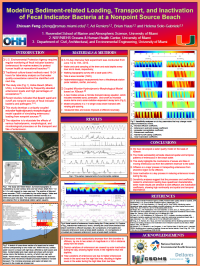CSDMS 2014 annual meeting poster Zhixuan Feng
Ad Reniers, University of Miami Miami Florida, United States.
Brian Haus, University of Miami Miami Florida, United States.
Helena Solo-Gabriele, University of Miami Coral Gables Florida, United States.
Abstract:
Enterococci are the U.S. Environmental Protection Agency (EPA) recommended fecal indicator bacteria for assessing recreational marine water quality. Traditional methods of enterococci analyses are time consuming, resulting in delays in issuing beach closures. Models can potentially circumvent these delays by forecasting times when beaches should be closed. The objective of this study is to develop an innovative coupled microbe-hydrodynamic-morphological model. The unique feature of this model is its capability of simulating the release of microbes attached to coastal beach sands as a result of combined wave and tidal forcing. A nearshore process model (XBeach) was coupled with a microbe transport-decay equation. This equation included source functions that accounted for microbial release from mobilized sand, groundwater flow, entrainment through pore water diffusion, rainfall-runoff loading, and a fate function that accounted for solar inactivation effects. The model successfully simulated observed spatial and temporal patterns of enterococci in the beach water, including the reproduction of diel and tidal fluctuations and the rapid decrease of enterococci levels from the waterline to offshore. Primary processes for enterococci loading to the water column included wave-induced sediment resuspension and tidal washing for the entrainment of enterococci from the pore water in the intertidal zone. Diffusion was the major mechanism to transport enterococci from the intertidal zone to offshore. Sunlight inactivation was a key process to reduce enterococci levels during the day and to produce the diurnal cycles. Rainfall runoff was found to be an intermittent source of enterococci to beach water, whereas groundwater exchange was of secondary importance. Sensitivity analyses suggested that the processes and coefficients related to enterococci loading have quasi-linear characteristics, whereas model results of enterococci levels were sensitive to both diffusion and sunlight inactivation coefficients, showing high nonlinearity and spatial and temporal dependence.
* Please acknowledge the original contributors when you are using this material. If there are any copyright issues, please let us know and we will respond as soon as possible.

